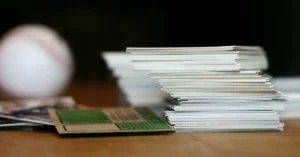Get a grip on defensive tactics with my expert insights: what is a charge in basketball? Explore the defensive maneuver and its role in disrupting offensive plays.
What Is a Charge in Basketball?
Definition and Importance
A charge occurs in basketball when you, as an offensive player, make illegal contact with a defender who has established a stationary position. It’s a strategic play that can prevent scores and gain possession for your team.
For a moment to be classified as a charge, not only does the defender need to be set in place before you make contact, but this also must happen outside the restricted area near the basket. The importance of a charge lies in its ability to deter reckless movement toward the basket, encourage safer play, and ultimately award ball possession to the defending team if executed correctly.
Charge Vs. Block
When distinguishing a charge from a block, the positioning of the defender is key:
- Charge: You make contact with a defender who’s stationary and not in the restricted area. The result is a foul on you, and the ball is awarded to the other team.
- Block: If the defender is moving, hasn’t established position, or is inside the restricted area when contact is made, the foul is typically on them, known as a block.
Executing and Defending Against Charges

Strategies for Taking a Charge
To successfully take charge, you need to be a defensive player who is keenly aware of positioning. Here’s how you can position yourself to draw a charge effectively:
- Establish Legal Guarding Position: Make sure you’re set with both feet on the court and facing the offensive player before they begin their upward motion.
- Remember, you must not be moving when the contact occurs.
- Stay Outside the Restricted Area: Ensure you’re outside the semi-circle under the basket to avoid an illegal positioning call.
By mastering these steps, you can draw an offensive foul on your opponent, potentially leading to a change in possession and an added foul to the offending player’s count.
How to Avoid Committing a Charge
You want to avoid getting called for a charging foul as an offensive player. Keep these tips in mind to prevent committing a charge:
- Be Aware of Defenders: Always watch the defender’s position, especially when driving towards the basket.
- Control Your Movement: Use body control to avoid crashing into a stationary defender who has set their position.
Rules and Regulations

NBA and NCAA Charge Rules
In the NBA, a charge is called when an offensive player makes illegal contact with a defender who has established a legal guarding position. To draw a charge, the defender must not be inside the restricted area near the basket. If the contact occurs within this arc, it’s more likely that a blocking foul will be called on the defender instead of a charge on the attacker.
- Key Elements for a Charge in the NBA:
- Defender must be outside the restricted area
- Defender must have both feet set
- Defender must be facing the offensive player
The NCAA rules are similar but have their own nuances. Charges in college basketball also hinge on the legal guarding position but account for the defender’s ability to move laterally or obliquely, provided they do not turn into the offensive player.
- Key Elements for a Charge in the NCAA:
- Defender must initially establish a legal guarding position
- Defender must be in legal guarding position when contact occurs
- Restricted area rules apply, but dimensions may differ from the NBA
Defining Legal Guarding Position
For a defender to draw a charge, they must be in what is known as a legal guarding position. This concept is vital in both the NBA and NCAA and has a few components:
- Initial Position: The defender must have both feet on the court.
- Facing the Opponent: The defender’s torso must face the offensive player.
Impact on the Game

Changing Possession and Scoring
A charge leads immediately to a turnover, which strips the offensive team of its chance to score. The defensive team gains possession, allowing them to score points instead. This swing can shift the momentum of the game, making charges a pivotal moment in tight matches.
Effect on Player and Team Fouls
Charges contribute to a player’s foul count, which can lead to them fouling out of the game if they exceed the limit. Since a charge is a personal foul, it affects the total of the team’s foul. An increase in team fouls can place the opposing team in a bonus situation, where they may get free throws for non-shooting fouls—thus impacting the game’s scoring dynamic.
Identifying Charges in Action

Role of Referees and Officials
Referees are the guardians of fairness on the court, and it’s their job to distinguish between a charge and a block. They watch for an offensive foul when you, as the ball handler, make significant contact with a defender in a legal guarding position. To make this call, officials look for specific criteria:
- The defender’s feet are set before the contact.
- The defender is not within the restricted zone under the basket.
- The offensive player initiates the contact.
If these conditions are met and a charge is called, you’ll notice the referee signal by extending their arm straight out from their side, palm open.
Common Charge Scenarios in Play
Several typical scenarios often lead to charges being called during a game:
- Drive to the Basket: If you drive towards the basket and crash into a defender already in position, officials will likely call a charge.
- Posting Up: While backing down a defender, if you push back too aggressively and the defender is in a legal spot, that could result in a charge.
- Out of Control Play: When you lose control of your movement and collide with a defender who’s set, expect a whistle for a charge.
FAQ
What is a charge in the NBA?
In the NBA, a charge occurs when a defensive player establishes legal guarding position and absorbs contact from an offensive player driving to the basket. If the offensive player makes significant contact with the defender who has established position, a charging foul is called, resulting in a turnover and possession awarded to the defending team.
What is the difference between a block and a charge?
A block occurs when a defensive player attempts to defend against a shot or a driving offensive player but fails to establish legal guarding position, resulting in contact initiated by the defensive player. In contrast, a charge occurs when a defensive player establishes legal guarding position and absorbs contact initiated by the offensive player, resulting in a foul called against the offensive player.
What is the charge line in basketball?
The charge line, also known as the restricted area or restricted circle, is a semicircular area located beneath the basket in basketball. In the NBA, the charge circle has a radius of four feet from the center of the basket. Offensive fouls cannot be called on defensive players positioned inside the charge circle when attempting to draw a charging foul. This rule prevents defenders from positioning themselves directly beneath the basket to draw charging fouls.
If you enjoyed reading about the topic: What Is a Charge in Basketball, leave a comment and stay updated on Pinterest for more exciting basketball news.
Leave me a comment and make sure to also check out How to Play Basketball Overseas.





